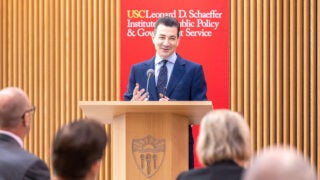
USC experts say the interest rate cut will influence housing, transportation infrastructure, tech innovation and global trade. (Illustration/iStock)
What the Federal Reserve’s interest rate cuts mean for California’s economy
USC experts discuss how the central bank’s rate cuts are likely to bring mixed outcomes for California’s key sectors, from housing and transportation to technology and trade.
The U.S. Federal Reserve announced this week it would cut interest rates by 0.5% — its first cut since March 2020 — in an attempt to stimulate the U.S. economy as inflation shows signs of easing.
The potential effects on California’s economy — the fifth largest in the world — promise to be wide-ranging. The results of the cut will influence housing, transportation infrastructure, tech innovation and global trade, according to USC experts.
“Lower borrowing costs will drive business investments, boost cargo volumes and improve the flow of goods through Southern California. While inflation had been a major concern, recent signs of its stabilizing provide optimism that this growth can happen without reigniting price pressures,” said Nick Vyas, director of the Center for Global Supply Chain Management at the USC Marshall School of Business.
“However, we must stay vigilant in balancing economic expansion with long-term inflation control,” he added.
Rate cuts won’t thaw California’s frozen housing market
While lower interest rates typically boost housing market activity, USC experts say California’s high home prices, tight housing supply and rising construction costs may dampen their impact.
Richard K. Green, director of the USC Lusk Center for Real Estate, explains the anticipated rate cuts have likely been factored into current mortgage rates, meaning they may not incentivize many homeowners to sell, especially those with low existing rates.
“The rates will not come down enough to unfreeze sales, because people with rates of less than 4% (about two-thirds of the market) are not going to want to sell their homes,” said Green, who holds the Lusk Chair in Real Estate and is also a professor at USC Marshall and the USC Price School of Public Policy.
While the rate cuts could provide some financial relief for homeowners with adjustable-rate mortgages by lowering their monthly payments, this group represents a small portion of the market, he said.
Experts also note while lower rates typically encourage home buying and new construction, California’s challenges are likely to lead to higher prices for existing homes rather than a surge in new housing developments.
Matthew Kahn, a Provost Professor of economics and spatial sciences at the USC Dornsife College of Letters, Arts and Sciences, explains as interest rates decline, homebuyers bid more aggressively for homes because the monthly mortgage payment declines.
“In areas where real estate developers can build new housing, low interest rates stimulate a boom. In areas where it is difficult to build new housing, perhaps due to NIMBYism or hilly terrain, existing homes will be bid up in value,” Kahn said.
Lower rates, sales tax revenue will boost transportation projects ahead of the 2028 L.A. Olympics
While the impact on the housing market may be limited due to high home prices, the lower interest rates could be a boon for California’s transportation infrastructure, particularly as the state prepares for the 2028 Olympics in Los Angeles.
With efforts underway to expand public transit, modernize freight transportation systems and improve roadways, USC experts say cheaper borrowing costs will ease the financial burden on the state.
HOW FED RATE CUTS COULD FAST-TRACK CALIFORNIA’S TRANSIT UPGRADES: Q&A with Genevieve Giuliano
Lower interest rates could speed up California’s transportation projects, potentially reducing costs and accelerating construction ahead of the 2028 Olympics in Los Angeles.
“As with all investments, lower interest rates make borrowing cheaper and therefore reduce costs,” said Genevieve Giuliano, interim dean and Distinguished Professor of public policy and Ferraro Chair in Effective Local Government at USC Price. “Interest rates affect these investments by reducing the borrowing costs for private contractors who do most of the construction. This translates to lower construction costs, allowing our public funds to go further.”
For California’s tech industry, rate cuts come with risks and rewards
California’s tech industry, which supports over a million jobs and accounts for more than 10% of the state’s economic output, could see mixed impacts from lower interest rates, according to USC experts.
Milan Miric, an associate professor of data sciences and operations at USC Marshall, notes rising interest rates in recent years have slowed consumer spending on big-ticket items like iPhones, cars and homes, affecting tech giants like Apple that rely on consumer purchases. The real growth in tech, he said, has come from enterprise AI, with major players like Microsoft, Amazon and Google thriving by selling tools to businesses rather than individual consumers.
“Smaller tech companies have struggled amid higher borrowing costs and competition from safer investments like U.S. Treasurys. The Fed’s interest rate cuts will provide them with some relief, but likely won’t change much,” Miric said.
Paul Orlando, director of the USC Incubator Program and an adjunct professor for the Lloyd Greif Center for Entrepreneurial Studies at USC Marshall, added that lower rates can help smaller tech firms attract more investment dollars. However, he cautions this can also lead to investors pressuring startups to expand too rapidly.
“Times of higher rates or just a poor economy in general can actually be a good time to build startups. Founders are forced to be scrappy — they can often hire people who they couldn’t afford in better markets and they build good practices for running an efficient business,” he said. “The risk is then whether the founders can shift styles when the situation changes.”
SoCal on track to reinforce its position as a global trade leader
Southern California is home to two of the largest ports in the United States, the Port of Los Angeles and the Port of Long Beach, which together handle about 40% of the nation’s containerized imports with cargo valued at over $500 billion each year. USC experts predict the central bank’s rate cuts will further boost these critical trade hubs.
“Federal Reserve interest rate cuts will energize global supply chains, with the San Pedro Bay ports at the heart of this transformation,” said Vyas, assistant professor of clinical data sciences and operations at USC Marshall.
However, Vyas warns policymakers, business leaders and other economic stakeholders must stay vigilant in balancing economic expansion with long-term inflation control:
“Southern California is poised to strengthen its position as a global trade leader, but maintaining this balance will ensure sustainable growth.”



